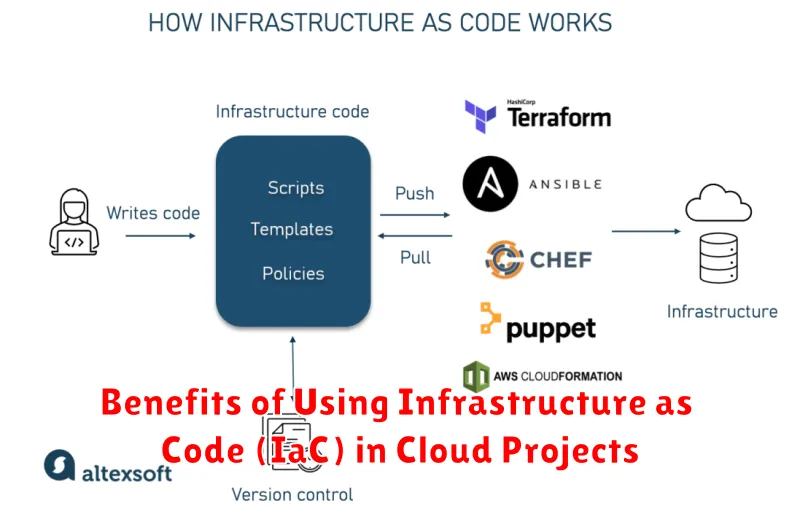In today’s rapidly evolving technological landscape, cloud computing has become essential for businesses seeking scalability, agility, and cost-effectiveness. Leveraging the cloud’s full potential requires efficient management of its underlying infrastructure. This is where Infrastructure as Code (IaC) emerges as a game-changer. IaC offers a transformative approach to managing and provisioning cloud resources, enabling organizations to define and manage their infrastructure through code, rather than traditional manual processes. This paradigm shift brings numerous benefits, streamlining workflows, reducing errors, and accelerating cloud project deployments.
This article will delve into the key benefits of using Infrastructure as Code (IaC) in your cloud projects. We will explore how IaC empowers teams to achieve greater efficiency, enhanced security, improved collaboration, and significant cost savings. From increased automation and improved consistency to faster deployment times and enhanced scalability, the advantages of IaC are compelling for any organization looking to optimize their cloud infrastructure management.
What Is Infrastructure as Code?
Infrastructure as Code (IaC) is the management and provisioning of infrastructure through code instead of manual processes. It involves using configuration files that define the desired state of your infrastructure, allowing you to automate the deployment, scaling, and management of resources.
These configuration files can be treated like any other software code: placed under version control, subject to automated testing, and part of a continuous integration/continuous deployment (CI/CD) pipeline. This approach eliminates the need for manual configuration and ensures consistency and repeatability across different environments.
IaC can be used to manage various infrastructure components, including virtual machines, networks, load balancers, databases, and security groups. By defining these resources in code, you gain greater control, reduce the risk of human error, and increase the speed and efficiency of infrastructure management.
Tools Like Terraform, Pulumi, CloudFormation
Several tools facilitate Infrastructure as Code (IaC) implementation, each with its strengths and weaknesses. Choosing the right tool depends on factors like project complexity, team expertise, and desired cloud platform integration. Three popular choices include Terraform, Pulumi, and CloudFormation.
Terraform, a widely adopted open-source tool, uses HashiCorp Configuration Language (HCL) or JSON to define and provision infrastructure across multiple cloud providers. Its strong multi-cloud support and large community contribute to its popularity.
Pulumi offers a more modern approach, enabling infrastructure management using familiar programming languages like Python, JavaScript, Go, and TypeScript. This allows developers to leverage existing coding skills and benefit from richer tooling for testing and debugging. Pulumi also supports multiple cloud platforms.
CloudFormation is Amazon Web Services’ native IaC service. It uses JSON or YAML to define and manage AWS resources. While tightly integrated with the AWS ecosystem, CloudFormation’s primary focus is AWS, making it less suitable for multi-cloud deployments.
Why IaC Improves Consistency and Speed
Infrastructure as Code (IaC) significantly enhances consistency and speed in cloud deployments by representing infrastructure configurations in a declarative or imperative format. This approach eliminates manual processes, which are prone to human error and inconsistencies. By defining infrastructure as code, teams ensure that every deployment follows the same predefined blueprint, minimizing configuration drift and ensuring predictable results.
IaC promotes speed by automating the provisioning and configuration of infrastructure. Instead of manually configuring servers, networks, and other components, IaC allows for rapid and automated deployments. This automation reduces the time required to set up environments, enabling faster iteration and faster time to market for applications.
Furthermore, IaC facilitates the creation of reusable modules and templates. These reusable components can be leveraged across multiple projects, further accelerating the deployment process and ensuring consistent configurations across different environments. The ability to quickly and reliably replicate infrastructure reduces the risk of errors and delays associated with manual setup, leading to more efficient and predictable outcomes.
Version Control and Team Collaboration

IaC facilitates robust version control for your infrastructure configurations. Just like software code, infrastructure code can be stored in version control systems like Git. This allows for tracking changes, reverting to previous configurations, and managing different versions of your infrastructure.
Using version control promotes collaboration among team members. Multiple engineers can work on infrastructure code simultaneously, merging their changes seamlessly. This fosters a collaborative environment and improves team productivity.
With IaC, the entire infrastructure setup becomes transparent and auditable. Changes are documented and tracked, making it easy to understand who made a change, when, and why. This accountability is crucial for troubleshooting issues and ensuring compliance with regulations.
Version control also simplifies the process of rolling back changes. If a deployment fails or introduces unintended consequences, the team can quickly revert to a previous stable version of the infrastructure configuration. This minimizes downtime and reduces the risk associated with infrastructure changes.
Automated Testing and CI/CD Integration
IaC facilitates seamless integration with automated testing and Continuous Integration/Continuous Delivery (CI/CD) pipelines. Infrastructure code, like application code, can be subjected to rigorous testing.
Automated tests can verify that infrastructure configurations are correct, secure, and compliant with organizational standards. This includes unit tests, integration tests, and end-to-end tests. These tests can be integrated into a CI/CD pipeline, ensuring that infrastructure changes are automatically tested before deployment.
CI/CD integration allows for automated provisioning and deployment of infrastructure, reducing manual intervention and accelerating the delivery of cloud resources. By incorporating infrastructure changes into the CI/CD pipeline, organizations can achieve faster time-to-market, increased deployment frequency, and improved reliability.
Security and Compliance Advantages
IaC facilitates the automation of security best practices during infrastructure provisioning. By defining security configurations in code, you ensure consistent application across all environments, minimizing the risk of human error and configuration drift. This coded approach allows for automated security audits and vulnerability scanning, enabling faster identification and remediation of security flaws.
Compliance requirements can be codified and enforced through IaC. This allows organizations to establish a standardized approach to compliance and automatically check for adherence to regulations. Automated documentation generation simplifies audit trails and reporting, streamlining compliance validation processes.
Version control systems, integral to IaC, provide a detailed audit history of all infrastructure changes. This makes it easier to identify the root cause of security issues, track down unauthorized modifications, and quickly roll back to previous, secure configurations.
Scaling and Reusability of IaC Scripts

IaC excels in enabling scalable and reusable infrastructure deployments. Scripts can be easily replicated and modified to create multiple, identical environments, reducing manual effort and ensuring consistency. This is especially beneficial for creating development, testing, and production environments that mirror each other closely.
Reusability is a key advantage of IaC. Scripts can be parameterized and modularized, enabling their use across different projects and teams. This promotes standardized infrastructure configurations and accelerates deployment times. Teams can leverage pre-built modules for common tasks, such as setting up web servers or databases, instead of recreating them from scratch.
This approach significantly reduces the time and resources needed to manage infrastructure, allowing teams to focus on developing and deploying applications more efficiently. Changes to infrastructure can be applied consistently across all environments by simply updating the IaC scripts.

